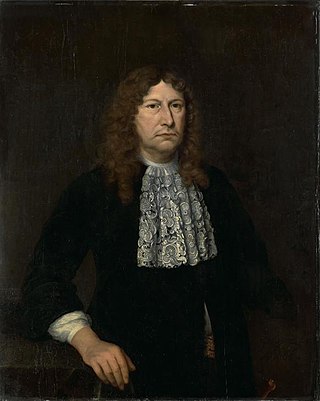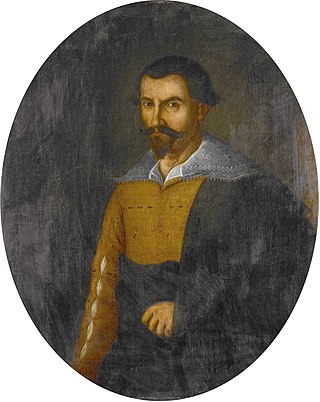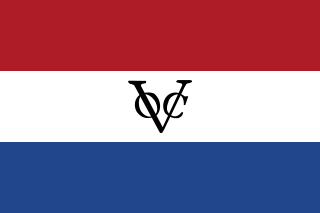The following lists events that happened during the 1660s in South Africa.

Johannes Camphuys was the Governor-General of the Dutch East Indies from 1684 to 1691. Camphuys was born in Haarlem, in the Republic of the United Netherlands.

Simon van der Stel was the first Governor of the Dutch Cape Colony (1691), the settlement at the Cape of Good Hope. He was interested in botany, establishing vineyards Groot and Klein Constantia, and producing a famous dessert wine. He is considered one of the founders of South African viticulture.

Pieter de Carpentier was a Dutch administrator of the Dutch East India Company (VOC) who served as Governor-General there from 1623 to 1627. The Gulf of Carpentaria in northern Australia is named after him.

Hubert Hugo served as a merchant for the Dutch East India Company (VOC) from 1640 to 1654 in Gujarat. He later turned to privateering or piracy in the Arabian Sea and the Gulf of Aden around 1662. In 1664, he was acquitted by the States of Holland and returned to the service of the VOC. He served as commander of Mauritius until 1677. In 1674 he became one of the last people to document the presence of the dodo on Mauritius.

Hartog Plate or Dirk Hartog's Plate is either of two pewter plates, although primarily the first, which were left on Dirk Hartog Island on the western coast of Australia before European settlement there. The first plate, left in 1616 by Dutch explorer Dirk Hartog, is the oldest-known artefact of European exploration in Australia still in existence. A replacement, which includes the text of the original and some new text, was left in 1697; the original dish was returned to the Netherlands, where it is now on display in the Rijksmuseum. Further additions at the site, in 1801 and 1818, led to the location being named Cape Inscription.

Pieter de Bitter was a 17th-century Dutch officer of the Dutch East India Company. On 12 August 1665 he won the Battle of Vågen against an English flotilla commanded by Thomas Teddeman.

Pieter van den Broecke was a Dutch cloth merchant in the service of the Dutch East India Company (VOC), and one of the first Dutchmen to taste coffee. He also went to Angola three times. He was one of the first Europeans to describe societies in West and Central Africa and to comment in detail trade strategies along the African coast.

Jacques Specx was a Dutch merchant, who founded the trade on Japan and Korea in 1609. Jacques Specx received the support of William Adams to obtain extensive trading rights from Tokugawa Ieyasu, the shōgun emeritus, on 24 August 1609, which allowed him to establish a trading factory in Hirado on 20 September 1609. He was the interim governor in Batavia between 1629 and 1632. There his daughter Saartje Specx was involved in a scandal. Back home in Holland Specx became an art-collector.
The Arnhem or Aernem was a Dutch East Indiaman sailing vessel that was shipwrecked 12 February 1662 off Mauritius on the Saint Brandon Rocks.

Dutch Malabar also known by the name of its main settlement Cochin, were a collection of settlements and trading factories of the Dutch East India Company on the Malabar Coast between 1661 and 1795, and was a subdivision of what was collectively referred to as Dutch India. Dutch presence in the Malabar region started with the capture of Portuguese Quilon, expanded with the Conquest of Malabar (1658-1663), and ended with the conquest of Malabar by the British in 1795. They possessed military outposts in 11 locations: Alleppey, Ayacotta, Chendamangalam, Pappinivattom, Ponnani, Pallipuram, Cranganore, Chetwai, Cannanore, Cochin, and Quilon.
Cornelis van Quaelberg, also written as van Quaelbergen or van Quaalberg was the third commander of the Dutch Cape Colony from 1666 to 1668.

The Veerse Compagnie was a pre-company from the Republic of the Seven United Netherlands that was founded by Balthazar de Moucheron, a ship owner from Antwerp in the Southern Netherlands. After the fall of Antwerp in 1585, he moved his business to Zeeland. The fleet of the Veerse Compagnie was made up of two ships; 'Leeuw' (Lion) and 'Leeuwin' (Lioness) and was headed by Cornelis Houtman. Its fleet left from Veere on 28 March 1598 and returned to the Republic of the Seven United Netherlands in 1600.
Hofwegen was an 18th-century Dutch fluyt. Built in 1731 in Rotterdam, the ship entered the service of the Dutch East India Company (VOC). The ship is recorded as making several voyages the Dutch colony of Batavia in Indonesia. She made the majority of these voyages at the behest of the "Rotterdam Room", a collection of merchants from Rotterdam.

IJsbrand Godske was the second Governor of the Dutch Cape Colony. After the death of Governor Pieter Hackius's on 30 November 1671, Godske was appointed to succeed him with the title of Governor and Councillor Extraordinary of India. For the time it took him to arrive at the Cape, first the Political Council and from 23 March 1672 to 2 October 1672, the secunde, Albert van Breugel, acted as governor.
Horssen was an East Indiaman operated by the Delft chamber of the Dutch East India Company. She was launched in 1784 and made the voyage to the Far East in 1786. She then had sailed for several nearby ports in Asia, when she finally set out for the successful return voyage in 1791, carrying aboard the prisoner Mary Bryant to Cape Town. After arriving in Europe in 1792 she was put out of service.
Pieter Hackius was the fifth commander of the Cape of Good Hope before it became the Dutch Cape Colony in 1691. Hackius succeeded Jacob Borghorst as commander on 25 March 1670 and was appointed to a position similar to governor on 2 June 1670.
Albert van Breugel was the acting commander of the Cape of Good Hope between April 1672 and 2 October 1672. He succeeded Governor Pieter Hackius after his death on 30 November 1671. Between Hackius's death and Breugel's appointment, the administration in the Cape was overseen by the Political Council.
Hendrik Crudop was a VOC official who also acted as commander at the Cape of Good Hope after the death of Commander Johan Bax van Herenthals in 1678 until the arrival of Simon van der Stel.

Wapen van Holland was a 17th-century merchant ship of the Dutch East India Company.












